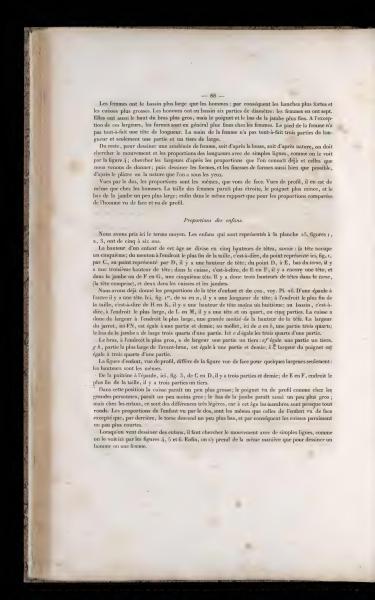Women have wider hips than men: thus stronger hips and thicker thighs. Men have a diameter of six parts in the pelvis, while women have seven. They also have thicker upper arms, but their wrists and the lower part of their legs are finer. Except for widths, the forms are generally finer in women. A woman's foot is not quite the length of a head. A woman's hand does not quite measure three parts in length and only one part and one third in width.
Furthermore, to draw a female form, whether from a model or from life, one must seek the movement and proportions of lengths using simple lines, as seen in figure 4; find widths using the proportions already known and those we have just given; then draw the forms, and the subtleties of forms as well as possible, using plaster casts or the natural form in view.
Viewed from the back, the proportions are the same as from the front. Viewed from the side, they resemble those of men. The waist of women appears narrower, the wrist thinner, and the lower leg a bit wider; all in the same proportion as the compared proportions of the man seen from the front and in profile.
Proportions of Children
We have taken the average here. The children represented in plate 25, figures 1, 2, 3, are between five to six years old.
The height of a child of this age is divided into five head heights: the head occupies one-fifth; from the chin to the narrowest point of the waist, i.e., from point C, as represented here in fig. 1, to point D, there is one head height; from point D to E, down the thigh, there is a third head height; in the thigh, i.e., from E to F, there is another head, and from the leg or from F to G, a fifth head measurement. Thus, there are three head heights in the torso (including the head), and two in the thighs and legs.
We have already given the proportions for the child's head and neck, see Pl. 16. From one shoulder to the other, there is one head. Here, fig. 1, from m to n, there is one head length; at the narrowest point of the waist, i.e., from H to K, there is a head height minus one eighth; a pelvis, i.e., at the widest point, from L to M, there is a head and a quarter, or five parts. The head gives width to the widest point, a large half of the head height. The width of the calf, here FN, equals one and a half parts; at the calf, here from a to b, one part three quarters; the lower leg width is three quarters of one part. Here c d equals three quarters of one part.
The sides, the wrist being thicker, at a width of one part three-quarters; equals one part and a quarter; R the widest part of the forearm equals one and a half parts; R wrist width equals three quarters of one part.
The child’s figure, viewed in profile, differs from the figure viewed from the front only in some widths: the heights are the same.
- From chest to shoulder, here fig. 3, from C to D, there are three and a half parts; from E to F, narrowest point of waist, there are three parts and one third.
In this position, the thigh appears slightly larger; the wrist seen in profile, just like in adults, appears slightly less thick; the lower leg appears slightly thicker too; but these differences are minimal in children, as their limbs are almost all round at that age. Child proportions seen from the back are similar to those seen from the front, except that the torso descends a bit lower at the back, making the thighs appear slightly shorter.
When drawing children, one must seek movement with simple lines, as shown here in figures 4, 5, and 6. Finally, the approach is the same as for drawing a man or a woman.
Translation Notes
Head Height: A measure using the height of a person’s head as a unit of proportion. Three parts: Refers to segments or divisions within a measurement.
The text discusses the differences in body proportions between women and men, noting broader hips and finer limbs in women. A section provides guidelines on how to draw these differences. Another section describes the proportions of children, dividing a child's height into segments relative to the size of the head, providing detailed instructions on drawing these features from different angles. Emphasis is on using simple lines to capture movement and proportions effectively.
